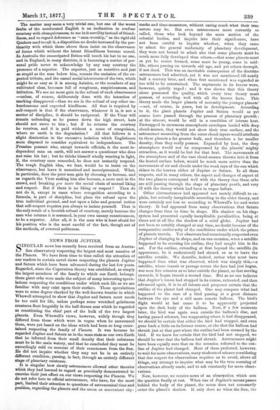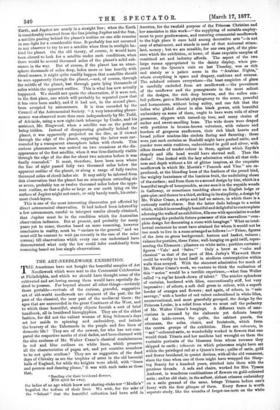NEWS FROM JUPITER.
SINGULAR news has recently been received from an Austra- lian observatory respecting the largest and most massive of the Planets. We have from time to time called the attention of our readers to certain novel views respecting the planets Jupiter and Saturn which have been advanced during the last few years. Regarded, since the Copernican theory was established, as simply the largest members of the family to which our Earth belongs, these giant orbs were made the subject of many interesting specu- lations respecting the conditions under which such life as we are familiar with may exist upon their surface. These speculations were to some degree checked by the well-known treatise in which Whewell attempted to show that Jupiter and Saturn must needs be too cold for life, unless perhaps some wretched gelatinous creatures float languidly in the half-frozen seas which he regarded as constituting the chief part of the bulk of the two largest planets. Even Whewell's views, however, widely though they differed from those which were in vogue when he announced them, were yet based on the ideas which had been so long enter- tained respecting the family of Planets. It was because he regarded Jupiter and Saturn as in the same state as our own Earth that he inferred from their small density that their substance must be in the main watery, and that he concluded they must be exceedingly cold on account of their remoteness from the Sun. He did not inquire whether they may not be in an entirely different condition, passing, in fact, through an entirely different stage of planetary existence.
It is singular how slowly astronomers allowed other theories which they had learned to regard as practically demonstrated to exercise their just effect on our views respecting the Planets. We do not refer here to official astronomers, who have, for the most part, limited their attention to questions of astronomical time and position, regarding the planets and the moon as convenient sky-
marks and time-measurers, without caring much what their tame nature may be. But even astronomers more correctly so called, those who look beyond the mere motion of the celestial bodies, and inquire into their significance, have not been careful to inquire whether, when they came to admit the general uniformity of planetary development, they were not bound to admit also that some planets must be much more fully developed than others,—that some planets must as yet be scarce formed, some must be young, some in mid- life, others passing on towards old age, and yet others decrepit, if not dead. This was an inevitable consequence of the doctrine astronomers had admitted, yet it was not mentioned till nearly half a century later, and when first mentioned was regarded as too wild to be entertained. The arguments in its favour were, however, quietly urged ; and it was shown that this theory alone possessed the quality, which every true theory must possess, of according well with all the known facts. This theory made the larger planets of necessity the younger planets' —not, of course, in years, but in development. According to it, the giant planets Jupiter and Saturn would as yet scarce have passed through the process of planetary growth ; at the utmost, would be still in a condition of intense heat. Enwrapped in enormous atmospheric envelopes loaded with deep cloud-masses, they would not show their true surface, and the astronomer measuring from the outer cloud-layers would attribute to these planets a far greater bulk, and therefore a far smaller density, than they really possess. Expanded by heat, the deep atmosphere would not be compressed by the planets' mighty attraction, as it would be but for that heat. The movements of the atmosphere and of the vast cloud-masses thrown into it from the heated surface below, would be much more active than the movements of air and clouds under the weak rays of the sun which shines in the heaven either of Jupiter or Saturn. In all these respects, and in many others, the aspect and changes of aspect of the two planets correspond well with the theory that these orbs are still passing through the stage of planetary youth, and very ill with the theory which had been in vogue before.
Other circumstances had appeared not merely difficult to ex- plain, but actually inexplicable according to the older theory, and were certainly not less so according to Whewell's ice-and-water theory. It had appeared from many observations that Saturn changes from time to time in shape. His shadow on his ring- system had presented equally inexplicable peculiarities, being at times not at all like the shadow of a solid globe. Jupiter had not been so notably changed at any time, no doubt because of the comparative uniformity of the conditions under which the prince of planets travels. Yet observers had occasionally suspected even Jupiter of changing in shape, and on one occasion, when a satellite happened to be crossing his outline, they had caught him in the act. For the outline, extending at first beyond the satellite (in appearance, be it understood) had shrunk so as to leave the satellite outside. We describe, indeed, rather what must have happened than what was observed, which was simply this,—a satellite, whose transit or passage across the face had just begun, was seen five minutes or so later outside the planet, so that moving onwards, it began transit a second time. But as no one believes that Jupiter's moon had stopped in its course, retreated, and then advanced again, it is to all intents and purposes certain that the outline of the planet had changed. One may compare what had happened to the case of a bird passing at a great distance between the eye and a still more remote balloon. The bird's flight would at last cause it to be apparently projected upon the dark body of the balloon. Now, if a few moments later, the bird was again seen outside the balloon's disc, not having passed athwart, but reappearing where it had disappeared, we should be certain that either the bird had stopped, and even gone back a little on its former course, or else that the balloon had shrunk just at that part where the outline had been crossed by the bird. If we knew for certain that the bird had not stopped, we should be sure that the balloon had shrunk. Astronomers might have been equally sure that on the occasion referred to the out- line of Jupiter had changed. Most of them preferred, however, to wait for more observations, many students of science considering that due respect for observations requires us to avoid, above all things, any attempt to inquire what may be the true meaning of observations already made, and to ask constantly for more obser- vations.
Now, however, we receive news of an observation which sets the question finally at rest. When one of Jupiter's moons passes behind the body of the planet, the moon does not necessarily enter the planet's shadow. It only does so when the Sun, the
Earth, and Jupiter are nearly in a straight line ; when the Earth is considerably removed from the line joining Jupiter and the Sun, a satellite passing behind the planet's outline on one side remains in sun-light for a considerable time. It probably has not occurred to any observer to try to see a satellite when thus in sunlight be- hind the planet. On the old theory, of course, it would have been absurd to look for a satellite under such conditions, when there would be several thousand miles of the planet's solid sub- stance in the way. But of course, if the planet has an atmo- sphere thousands of miles deep, laden more or less heavily with cloud-masses, it might quite readily happen that a satellite should be seen apparently through the planet,—not, of course, through the middle of the planet, bat through parts lying thousands of miles within the apparent outline. This is what has now actually happened. We should not quote the observation, if it were not, in the first place, one which will probably be repeated (now that it has once been made), and if it had not, in the second place,
• been accepted by astronomers. It is thus recorded by the Council of the Astronomical Society. "A very interesting pheno- menon was observed more than once independently by Mr. Todd, of Adelaide, using a new eight-inch telescope by Cooke, and his assistant, Mr. Ringwood, when a satellite was on the point of being hidden. Instead of disappearing gradually behind the planet, it was apparently projected on the disc, as if viewed through the edge of the planet, supposing the latter were fair- rounded by a transparent atmosphere laden with clouds. This curious phenomenon was noticed on two occasions at the dis- appearance of the first satellite, when it was thus distinctly visible through the edge of the disc for about two minutes before it was finally concealed." It must, therefore, have been seen where the line of sight passed fully two thousand miles below the apparent outline of the planet, or along a range of fully twelve thousand miles of cloud-laden air. It may safely be inferred from this observation that the planet has an atmosphere extending six or seven, probably ten or twelve thousand miles below the appa- rent outline, so that a globe as large as our earth lying on the surface of Jupiter might not reach, or only barely reach, his outer- most cloud-layers.
This is one of the most interesting discoveries yet effected by direct astronomical observation. It had indeed been inferred by a few astronomers, careful to interpret results already obtained, that Jupiter mast be in the condition which the Australian observation indicates. But at present, and probably for many years yet to come, theories based on mere reasoning, however conclusive in reality, must be "caviare to the general," and we must still be content to wait (as recently in the case of the solar corona) till observations which every one can understand have demonstrated what only the few could infer confidently from reasoning based on less simple observations.



































 Previous page
Previous page